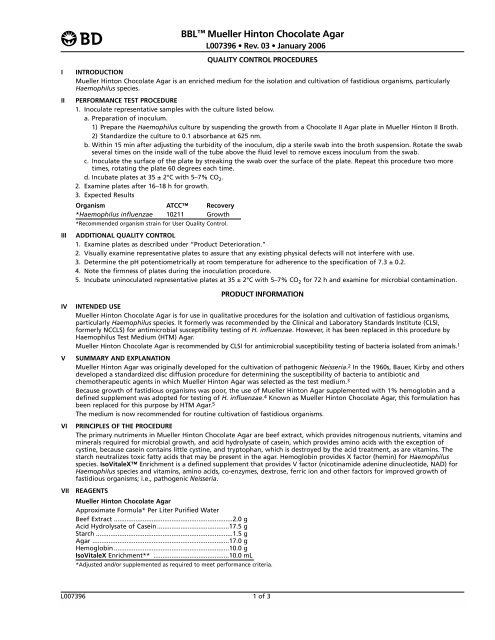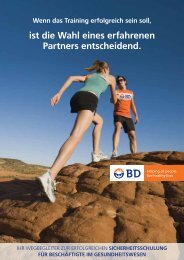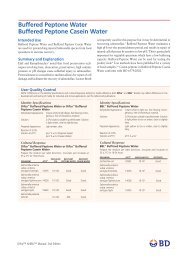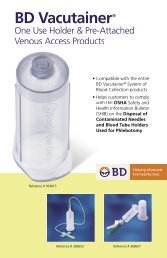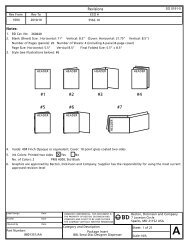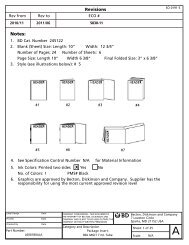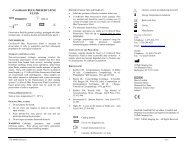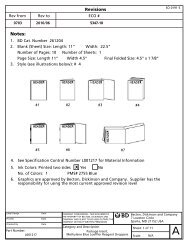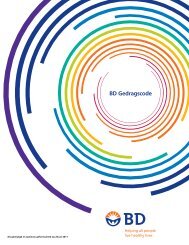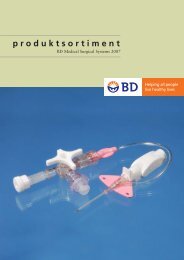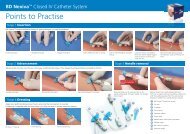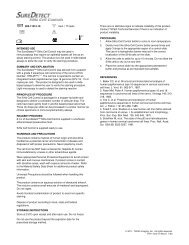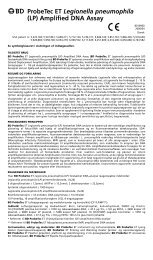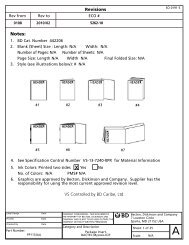BBL Mueller Hinton Chocolate Agar - BD
BBL Mueller Hinton Chocolate Agar - BD
BBL Mueller Hinton Chocolate Agar - BD
Create successful ePaper yourself
Turn your PDF publications into a flip-book with our unique Google optimized e-Paper software.
!<br />
<strong>BBL</strong> <strong>Mueller</strong> <strong>Hinton</strong> <strong>Chocolate</strong> <strong>Agar</strong><br />
L007396 • Rev. 03 • January 2006<br />
QUALITY CONTROL PROCEDURES<br />
I INTRODUCTION<br />
<strong>Mueller</strong> <strong>Hinton</strong> <strong>Chocolate</strong> <strong>Agar</strong> is an enriched medium for the isolation and cultivation of fastidious organisms, particularly<br />
Haemophilus species.<br />
II PERFORMANCE TEST PROCEDURE<br />
1. Inoculate representative samples with the culture listed below.<br />
a. Preparation of inoculum.<br />
1) Prepare the Haemophilus culture by suspending the growth from a <strong>Chocolate</strong> II <strong>Agar</strong> plate in <strong>Mueller</strong> <strong>Hinton</strong> II Broth.<br />
2) Standardize the culture to 0.1 absorbance at 625 nm.<br />
b. Within 15 min after adjusting the turbidity of the inoculum, dip a sterile swab into the broth suspension. Rotate the swab<br />
several times on the inside wall of the tube above the fluid level to remove excess inoculum from the swab.<br />
c. Inoculate the surface of the plate by streaking the swab over the surface of the plate. Repeat this procedure two more<br />
times, rotating the plate 60 degrees each time.<br />
d. Incubate plates at 35 ± 2°C with 5–7% CO2 .<br />
2. Examine plates after 16–18 h for growth.<br />
3. Expected Results<br />
Organism ATCC Recovery<br />
*Haemophilus influenzae 10211 Growth<br />
*Recommended organism strain for User Quality Control.<br />
III ADDITIONAL QUALITY CONTROL<br />
1. Examine plates as described under “Product Deterioration.”<br />
2. Visually examine representative plates to assure that any existing physical defects will not interfere with use.<br />
3. Determine the pH potentiometrically at room temperature for adherence to the specification of 7.3 ± 0.2.<br />
4. Note the firmness of plates during the inoculation procedure.<br />
5. Incubate uninoculated representative plates at 35 ± 2°C with 5–7% CO 2 for 72 h and examine for microbial contamination.<br />
PRODUCT INFORMATION<br />
IV INTENDED USE<br />
<strong>Mueller</strong> <strong>Hinton</strong> <strong>Chocolate</strong> <strong>Agar</strong> is for use in qualitative procedures for the isolation and cultivation of fastidious organisms,<br />
particularly Haemophilus species. It formerly was recommended by the Clinical and Laboratory Standards Institute (CLSI,<br />
formerly NCCLS) for antimicrobial susceptibility testing of H. influenzae. However, it has been replaced in this procedure by<br />
Haemophilus Test Medium (HTM) <strong>Agar</strong>.<br />
<strong>Mueller</strong> <strong>Hinton</strong> <strong>Chocolate</strong> <strong>Agar</strong> is recommended by CLSI for antimicrobial susceptibility testing of bacteria isolated from animals. 1<br />
V SUMMARY AND EXPLANATION<br />
<strong>Mueller</strong> <strong>Hinton</strong> <strong>Agar</strong> was originally developed for the cultivation of pathogenic Neisseria. 2 In the 1960s, Bauer, Kirby and others<br />
developed a standardized disc diffusion procedure for determining the susceptibility of bacteria to antibiotic and<br />
chemotherapeutic agents in which <strong>Mueller</strong> <strong>Hinton</strong> <strong>Agar</strong> was selected as the test medium. 3<br />
Because growth of fastidious organisms was poor, the use of <strong>Mueller</strong> <strong>Hinton</strong> <strong>Agar</strong> supplemented with 1% hemoglobin and a<br />
defined supplement was adopted for testing of H. influenzae. 4 Known as <strong>Mueller</strong> <strong>Hinton</strong> <strong>Chocolate</strong> <strong>Agar</strong>, this formulation has<br />
been replaced for this purpose by HTM <strong>Agar</strong>. 5<br />
The medium is now recommended for routine cultivation of fastidious organisms.<br />
VI PRINCIPLES OF THE PROCEDURE<br />
The primary nutriments in <strong>Mueller</strong> <strong>Hinton</strong> <strong>Chocolate</strong> <strong>Agar</strong> are beef extract, which provides nitrogenous nutrients, vitamins and<br />
minerals required for microbial growth, and acid hydrolysate of casein, which provides amino acids with the exception of<br />
cystine, because casein contains little cystine, and tryptophan, which is destroyed by the acid treatment, as are vitamins. The<br />
starch neutralizes toxic fatty acids that may be present in the agar. Hemoglobin provides X factor (hemin) for Haemophilus<br />
species. IsoVitaleX Enrichment is a defined supplement that provides V factor (nicotinamide adenine dinucleotide, NAD) for<br />
Haemophilus species and vitamins, amino acids, co-enzymes, dextrose, ferric ion and other factors for improved growth of<br />
fastidious organisms; i.e., pathogenic Neisseria.<br />
VII REAGENTS<br />
<strong>Mueller</strong> <strong>Hinton</strong> <strong>Chocolate</strong> <strong>Agar</strong><br />
Approximate Formula* Per Liter Purified Water<br />
Beef Extract ..................................................................2.0 g<br />
Acid Hydrolysate of Casein........................................17.5 g<br />
Starch ............................................................................1.5 g<br />
<strong>Agar</strong> ............................................................................17.0 g<br />
Hemoglobin ................................................................10.0 g<br />
IsoVitaleX Enrichment** ..........................................10.0 mL<br />
*Adjusted and/or supplemented as required to meet performance criteria.<br />
L007396 1 of 3
**IsoVitaleX Enrichment<br />
Approximate Formula* Per Liter Purified Water<br />
Vitamin B12 ..................................................................0.01 g<br />
L-Glutamine ................................................................10.0 g<br />
Adenine ........................................................................1.0 g<br />
Guanine Hydrochloride................................................0.03 g<br />
ρ-Aminobenzoic Acid ..................................................0.013 g<br />
Nicotinamide Adenine Dinucleotide (NAD) ..............0.25 g<br />
Thiamine Pyrophosphate ............................................0.1 g<br />
Ferric Nitrate ................................................................0.02 g<br />
Thiamine Hydrochloride ..............................................0.003 g<br />
Cysteine Hydrochloride..............................................25.9 g<br />
L-Cystine........................................................................1.1 g<br />
Dextrose ....................................................................100.0 g<br />
*Adjusted and/or supplemented as required to meet performance criteria.<br />
Warnings and Precautions: For in vitro Diagnostic Use.<br />
If excessive moisture is observed, invert the bottom over an off-set lid and allow to air dry in order to prevent formation of a<br />
seal between the top and bottom of the plate during incubation.<br />
Pathogenic microorganisms, including hepatitis viruses and Human Immunodeficiency Virus, may be present in clinical<br />
specimens. "Standard Precautions" 6-9 and institutional guidelines should be followed in handling all items contaminated with<br />
blood and other body fluids. After use, prepared plates, specimen containers and other contaminated materials must be<br />
sterilized by autoclaving before discarding.<br />
Storage Instructions: On receipt, store plates in the dark at 2–8°C. Avoid freezing and overheating. Do not open until ready to<br />
use. Minimize exposure to light. Prepared plates stored in their original sleeve wrapping at 2–8°C until just prior to use may be<br />
inoculated up to the expiration date and incubated for recommended incubation times. Allow the medium to warm to room<br />
temperature before inoculation.<br />
Product Deterioration: Do not use plates if they show evidence of microbial contamination, discoloration, drying, cracking or<br />
other signs of deterioration.<br />
VIII SPECIMEN COLLECTION AND HANDLING<br />
Specimens suitable for culture may be handled using various techniques. For detailed information, consult appropriate texts. 10,11<br />
Specimens should be obtained before antimicrobial therapy has been administered. Provision must be made for prompt delivery<br />
to the laboratory.<br />
IX PROCEDURE<br />
Material Provided: <strong>Mueller</strong> <strong>Hinton</strong> <strong>Chocolate</strong> <strong>Agar</strong><br />
Materials Required But Not Provided: Ancillary culture media, reagents, quality control organisms and laboratory equipment as<br />
required.<br />
Test Procedure: Observe aseptic techniques.<br />
The agar surface should be smooth and moist, but without excessive moisture.<br />
Streak the specimen as soon as possible after it is received in the laboratory. The streak plate is used primarily to isolate pure<br />
cultures from specimens containing mixed flora.<br />
Alternatively, if material is being cultured directly from a swab, roll the swab over a small area of the surface at the edge; then<br />
streak from this inoculated area.<br />
Incubate plates at 35 ± 2°C for 18–24 h and up to 72 h, if necessary, in an aerobic atmosphere enriched with 5–7% carbon dioxide. 12<br />
User Quality Control: See "Quality Control Procedures."<br />
Quality control requirements must be performed in accordance with applicable local, state and/or federal regulations or<br />
accreditation requirements and your laboratory's standard Quality Control procedures. It is recommended that the user refer<br />
to pertinent CLSI (formerly NCCLS) guidance and CLIA regulations for appropriate Quality Control practices.<br />
X RESULTS<br />
After a minimum of 18 h of incubation, the plates should show isolated colonies in streaked areas and confluent growth in<br />
areas of heavy inoculation.<br />
The growth of Haemophilus appears as small (1 mm), moist, pearly colonies with a characteristic “mousy” odor.<br />
XI LIMITATION OF THE PROCEDURE<br />
For identification, organisms must be in pure culture. Morphological, biochemical, and/or serological tests should be performed<br />
for final identification. Consult appropriate texts for detailed information and recommended procedures. 10,11,13-16<br />
XII AVAILABILITY<br />
Cat. No. Description<br />
221860 <strong>BBL</strong> <strong>Mueller</strong> <strong>Hinton</strong> <strong>Chocolate</strong> <strong>Agar</strong>, Pkg. of 20 plates<br />
221869 <strong>BBL</strong> <strong>Mueller</strong> <strong>Hinton</strong> <strong>Chocolate</strong> <strong>Agar</strong>, Pkg. of 8, 150 mm–style plates<br />
221802<br />
XIII REFERENCES<br />
<strong>BBL</strong> <strong>Mueller</strong> <strong>Hinton</strong> <strong>Chocolate</strong> <strong>Agar</strong>, Ctn. of 24, 150 mm–style plates<br />
1. National Committee for Clinical Laboratory Standards. 2002. Approved Standard M31-A2. Performance standards for antimicrobial disk and<br />
dilution susceptibility tests for bacteria isolated from animals, 2nd ed. NCCLS, Wayne, PA.<br />
2. <strong>Mueller</strong>, J.H., and J. <strong>Hinton</strong>. 1941. A protein-free medium for primary isolation of the gonococcus and meningococcus. Proc. Soc. Exp. Biol.<br />
Med. 48:330-333.<br />
3. Bauer, A.W., W.M.M. Kirby, J.C. Sherris, and M. Turck. 1966. Antibiotic susceptibility testing by a standardized single disk method. Am. J. Clin.<br />
Pathol. 45:493-496.<br />
L007396 2 of 3
4. National Committee for Clinical Laboratory Standards. 1984. Approved standard: M2-A3. Performance standards for antimicrobial disk<br />
susceptibility tests, 3rd ed. National Committee for Clinical Laboratory Standards, Villanova, Pa.<br />
5. National Committee for Clinical Laboratory Standards. 2003. Approved standard: M2-A8. Performance standards for antimicrobial disk<br />
susceptibility tests, 8th ed. National Committee for Clinical Laboratory Standards, Wayne, Pa.<br />
6. National Committee for Clinical Laboratory Standards. 2001. Approved Guideline M29-A2. Protection of laboratory workers from<br />
occupationally acquired infections, 2nd ed. NCCLS, Wayne, PA.<br />
7. Garner, J.S. 1996. Hospital Infection Control Practices Advisory Committee, U.S. Department of Health and Human Services, Centers for<br />
Disease Control and Prevention. Guideline for isolation precautions in hospitals. Infect. Control Hospital Epidemiol. 17:53-80.<br />
8. U.S. Department of Health and Human Services. 1999. Biosafety in microbiological and biomedical laboratories, HHS Publication (CDC), 4th<br />
ed. U.S. Government Printing Office, Washington, D.C.<br />
9. Directive 2000/54/EC of the European Parliament and of the Council of 18 September 2000 on the protection of workers from risks related to<br />
exposure to biological agents at work (seventh individual directive within the meaning of Article 16(1) of Directive 89/391/EEC). Official<br />
Journal L262, 17/10/2000, p. 0021-0045.<br />
10. Murray, P.R., E.J. Baron, J.H. Jorgensen, M.A. Pfaller, and R. H. Yolken (ed.). 2003. Manual of clinical microbiology, 8th ed. American Society<br />
for Microbiology, Washington, D.C<br />
11. Forbes, B.A., D.F. Sahm, and A.S. Weissfeld. 2002. Bailey and Scott's diagnostic microbiology, 11th ed. Mosby, Inc., St. Louis.<br />
12. Campos, J.M. 1999. Haemophilus, p. 604-613. In P.R. Murray, E.J. Baron, M.A. Pfaller, F.C. Tenover, and R.H. Yolken (ed.), Manual of clinical<br />
microbiology, 7th ed. American Society for Microbiology, Washington, D.C.<br />
13. Holt, J.G., N.R. Krieg, P.H.A. Sneath, J.T. Staley, and S.T. Williams (ed.). 1994. Bergey's Manual of determinative bacteriology, 9th ed.<br />
Williams & Wilkins, Baltimore.<br />
14. MacFaddin, J.F. 2000. Biochemical tests for identification of medical bacteria, 3rd ed. Lippincott Williams & Wilkins, Baltimore.<br />
15. Koneman, E.W., S.D. Allen, W.M. Janda, P.C. Schreckenberger, and W.C. Winn, Jr. 1997. Color atlas and textbook of diagnostic microbiology,<br />
5th ed. Lippincott-Raven, Philadelphia.<br />
16. Isenberg, H.D. (ed.). 2004. Clinical microbiology procedures handbook, vol. 1, 2 and 3, 2nd ed. American Society for Microbiology,<br />
Washington, D.C.<br />
Becton, Dickinson and Company<br />
7 Loveton Circle<br />
Sparks, Maryland 21152 USA<br />
800-638-8663<br />
ATCC is a trademark of the American Type Culture Collection.<br />
<strong>BD</strong>, <strong>BD</strong> Logo, <strong>BBL</strong> and IsoVitaleX are trademarks of Becton, Dickinson and Company. ©2006 <strong>BD</strong>.<br />
L007396 3 of 3


